
Extatosoma is a genus of phasmids, in the monotypic subfamily Extatosomatinae, with two species. One occurs in Australia, one in New Guinea. Both have a colour morph imitating leaves, and one imitating lichen.

Agathemera is a genus of stick insects in the suborder Euphasmatodea and superfamily Pseudophasmatoidea. It consists of several species limited to the mountainous regions of Argentina, Bolivia, Chile and Peru.

The Phasmatidae are a family of the stick insects. They belong to the superfamily Anareolatae of suborder Verophasmatodea.

Cranidium is an monotypic genus of stick insects in the monotypic tribe Cranidiini. The single species Cranidium gibbosum has been recorded from northern Brazil, French Guiana, and Surinam.
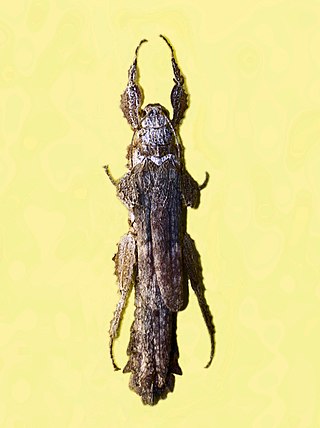
Prisopus is a genus of stick insects belonging to the family Prisopodidae. These stick insects are present in Central and South America, India and Malesia.
Charmides cerberus is a species of phasmid or stick insect of the monotypic genus Charmides. It is endemic to Sri Lanka.
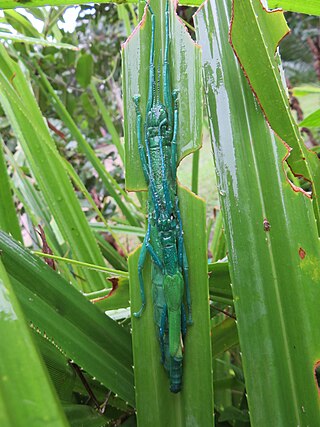
Megacrania is a genus of the subfamily Megacraniinae of stick insects. Members of this genus are commonly referred to as "peppermint stick insects", due to the characteristic odor of their defensive spray, as well as the cylindrical, twig-like shape of their bodies.

Platycraninae are an anareolate subfamily of stick insects in the family Phasmatidae. Their known distribution includes southern, southeast Asia and Australasia.

The Megacraniinae are an anareolate subfamily of stick insects in the family Phasmatidae. Their known distribution includes Malesia and islands in the Pacific and Indian oceans. Several genera have been revised and were placed previously in the Platycraninae.
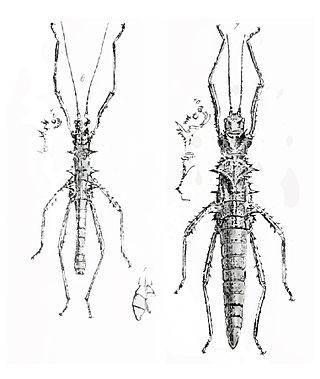
Acanthoderus is a monotypic genus of stick insects in the tribe Pachymorphini. The single species Acanthoderus spinosus has a known distribution in Australia.

Anchiale is a genus of stick insects in the family Phasmatidae and tribe Phasmatini. Species have a known distribution from Australasia. The type species, A. maculata, was originally thought to be a Mantis.

Paramenexenus is a genus of Asian stick insects belonging to the family Lonchodidae, erected by Josef Redtenbacher in 1908.

The Cladomorphinae are a subfamily of stick insects in the family Phasmatidae. This taxon is particularly well represented in the Neotropical region, but records also exist for Madagascar, Java and the Maluku Islands.
Sadyattes is a genus of stick insects in the subfamily Platycraninae and tribe Stephanacridini. Species have a known distribution from Sumatra and Borneo.
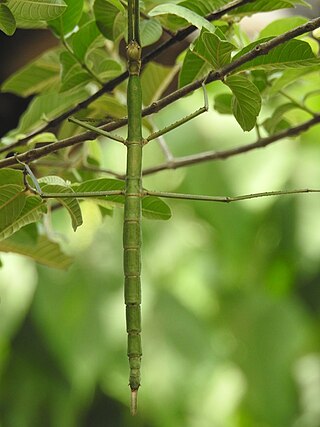
Nesiophasma is a genus of very large stick insects within the order Phasmatodea and the tribe of Stephanacridini. This genus is found in Wallacea west of Weber’s Line: Sulawesi, Peleng Island, Selayar Island, Kalaotoa Island, Sanana Island, Romang Island, Timor Island, Sangihe Island and Talaud Islands. New Guinea with doubt. The largest in the list of species is Nesiophasma giganteum, with females reaching a body length of 30 cm.
Neomedaura is currently a monotypic genus of Asian stick insects in the tribe Medaurini, erected by G.W.C. Ho in 2020. To date, one species has been recorded from Vietnam.
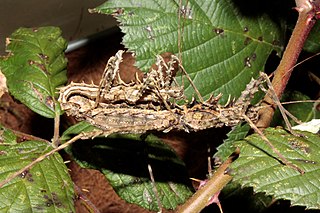
Brockphasma is currently a monotypic genus of Asian stick insects in the tribe Necrosciini, erected by G.W.C. Ho, Liu, Bresseel & Constant in 2014. To date, one species has been recorded from Vietnam.

Nuichua is a genus of Asian stick insects in the tribe Necrosciini, erected by J Bresseel and J Constant, in 2018. To date (2022) the sole species has been recorded from Vietnam.
Neooxyartes is a monotypic genus of Asian stick insects in the tribe Necrosciini, erected by G.W.C. Ho in 2018. To date (2022) the sole species has been recorded from Vietnam.

Spinohirasea is currently a monotypic genus of stick insects in the tribe Necrosciini, erected by Zompro in 2002. To date (2022) the sole species has been recorded from Vietnam.




















